The Moulin de la Galette is a windmill and associated businesses situated near the top of the district of Montmartre in Paris. Since the 17th century the windmill has been known for more than just its milling capabilities. Nineteenth-century owners and millers, the Debray family, made a brown bread, galette, which became popular and thus the name of the windmill and its businesses, which have included a famous guinguette and restaurant. In the 19th century, Le Moulin de la Galette represented diversion for Parisians seeking entertainment, a glass of wine and bread made from flour ground by the windmill. Artists, such as Renoir, van Gogh, and Pissarro have immortalized Le Moulin de la Galette; likely the most notable was Renoir's festive painting, Bal du moulin de la Galette.

Bal du moulin de la Galette is an 1876 painting by French artist Pierre-Auguste Renoir.

Santiago Rusiñol i Prats was a Spanish painter, poet, journalist, collector and playwright. He was one of the leaders of the Catalan modernisme movement. He created more than a thousand paintings and wrote numerous works in Catalan and Spanish.

Ramon Casas i Carbó was a Spanish artist. Living through a turbulent time in the history of his native Barcelona, he was known as a portraitist, sketching and painting the intellectual, economic, and political elite of Barcelona, Paris, Madrid, and beyond. He was also known for his paintings of crowd scenes ranging from the audience at a bullfight to the assembly for an execution to rioters in the Barcelona streets. Also a graphic designer, his posters and postcards helped to define the Catalan art movement known as modernisme.

The Museu Nacional d'Art de Catalunya, abbreviated as MNAC, is a museum of Catalan visual art located in Barcelona, Catalonia, Spain. Situated on Montjuïc hill at the end of Avinguda de la Reina Maria Cristina, near Pl Espanya, the museum is especially notable for its outstanding collection of romanesque church paintings, and for Catalan art and design from the late 19th and early 20th centuries, including modernisme and noucentisme. The museum is housed in the Palau Nacional, a huge, Italian-style building dating to 1929. The Palau Nacional, which has housed the Museu d'Art de Catalunya since 1934, was declared a national museum in 1990 under the Museums Law passed by the Catalan Government. That same year, a thorough renovation process was launched to refurbish the site, based on plans drawn up by the architects Gae Aulenti and Enric Steegmann, who were later joined in the undertaking by Josep Benedito. The Oval Hall was reopened in 1992 on the occasion of the Olympic Games, and the various collections were installed and opened over the period from 1995 to 2004. The Museu Nacional d'Art de Catalunya was officially inaugurated on 16 December 2004. It is one of the largest museums in Spain.

The Maricel Museum is a museum located in the centre of Sitges; reopened after a major refurbishment in 2015.
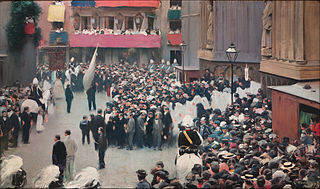
The Corpus Christi Procession Leaving the Church of Santa Maria del Mar is an oil painting by Ramon Casas painted in 1898 in Barcelona and currently in the Museu Nacional d'Art de Catalunya in Barcelona.
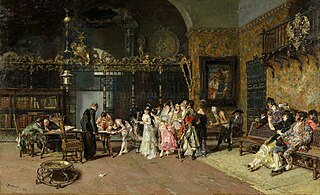
The Spanish Wedding or La Vicaría (1868–1870) is a masterwork by Marià Fortuny i Marsal, also known as Marià Fortuny or Mariano Fortuny. La Vicaría exemplifies genre painting of the 19th century. The use of jewel tones, contrasts between light and dark, and the virtuosity of the work attest to Fortuny's talent. It resides at Museu Nacional d'Art de Catalunya in Barcelona, Spain.

Desolation is a sculpture made by Josep Llimona 1907 which is part of the collection of the National Art Museum of Catalonia in Barcelona.
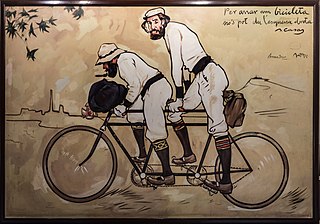
Ramon Casas and Pere Romeu on a Tandem is a painting by Ramon Casas in exhibition at the National Art Museum of Catalonia in Barcelona.

Over My Dead Body, 1893, is a painting by Ramon Casas, in the National Art Museum of Catalonia in Barcelona.
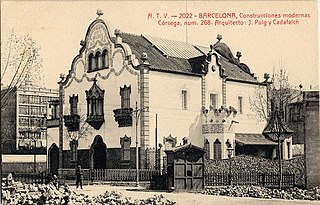
Casa Trinxet was a building designed by the Catalan Modernisme architect Josep Puig i Cadafalch and built during the years 1902–1904, officially considered completed in 1904. It was located at the crossroads of Carrer Balmes and Carrer del Consell de Cent, in the Eixample district of Barcelona, Catalonia, Spain. Casa Trinxet was "one of the jewels of Barcelona Modernisme" and one of the buildings of Barcelona's Illa de la Discòrdia, because of competing attitudes among Domènech i Montaner, Puig i Cadafalch and Antoni Gaudí.

Joaquin Mir Trinxet or Joaquin Mir y Trinxet was a Catalan artist known for his use of color in his paintings. He lived through a turbulent time in the history of his native Barcelona. His paintings helped to define the Catalan art movement known as modernisme.

The Odalisque is an 1861 oil painting by Spanish painter Marià Fortuny exhibited at the National Art Museum of Catalonia in Barcelona.

The Swing is an 1876 oil on canvas painting by the French artist Pierre-Auguste Renoir who was a leading exponent of the Impressionist style. The painting measures 92 x 73 centimetres and is in the Musée d’Orsay. Renoir executed the painting in what are now the Musée de Montmartre gardens. He had rented a cottage in the gardens so that he could be closer to the Moulin de la Galette where he was engaged in painting Bal du moulin de la Galette.
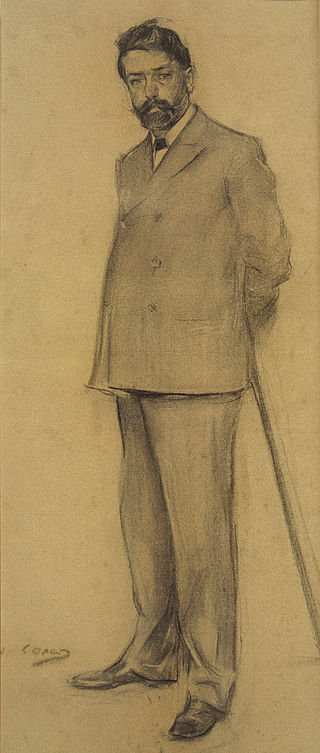
Lluís Graner i Arrufí, or Arrufat in Spanish was a Spanish painter in the Realistic style.

Eliseu Meifrèn i Roig was a Spanish Impressionist painter.

Garrote vil (Garrotte) is an 1894 painting by Ramon Casas, produced in Barcelona and now in the Museo Nacional Centro de Arte Reina Sofía in Madrid. It was first exhibited at Spain's National Exhibition of Fine Arts in 1895, where it won third prize and thus was bought by the state for the former Museo de Arte Moderno. From there it passed to the Prado Museum in 1971 and finally to its present home in 1995 due to a royal decree which re-allocated the Prado and Museo de Arte Moderno's collections.

A Romance is a genre painting by Spanish artist and author Santiago Rusiñol. Executed in Paris in 1894, it depicts French composer Erik Satie and his friend Stéphanie Nantas in a moment of intimate music making. It resides at the Museu Nacional d'Art de Catalunya in Barcelona.

Miquel Utrillo i Morlius was a Catalan art critic, scenographer, painter, and engineer.



















